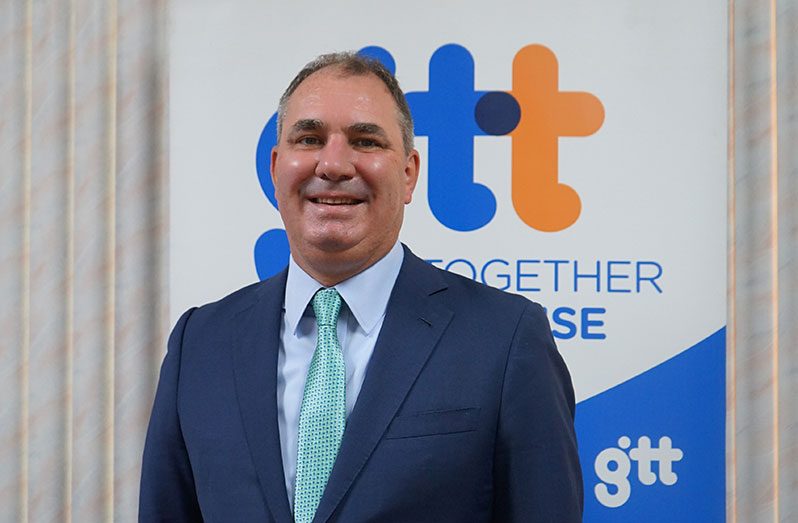–exploring wireless landline services, says new CEO
WITH over 75,000 of its customers already using its fibre optic “Blaze” system, the Guyana Telephone and Telegraph Company (GTT) is aiming to add another 10,000 customers to the facility this year, even as it introduces ways to improve on its DSL network as well.
The company also recently began implementing its Wi-fi mesh and Plume home-pass services, which are geared at delivering stronger connectivity to consumers.
In an exclusive interview with the Guyana Chronicle, GTT’s Chief Executive Officer (CEO), Damien Blackburn, said that the company is striving to “get the economics right” to ensure that every customer, who has fibre available in his/her community, is encouraged to move to the new system.
“We want everybody in Guyana in a fibre area to take on the fibre service, instead of using the traditional landline and DSL service. Fibre to the premises is the best way to consume your service, it’s most reliable, less prone to faults, and you will get the fastest speed on it which is very important for us because it’s easier for us to guarantee the service,” Blackburn related.
Fibre optic is a transmission alternative to the DSL which uses copper phone lines to transmit data. The fibre optic system uses ultra-thin glass strands that carry light instead of electricity, making for faster data transmission.
GTT launched its US$25 million “Blaze” high speed fibre optic system in 2017, which has since expanded widely across the country, with plans to expand even further.
“When you look at the raw statistics Guyana is doing very well. We benchmark pretty well as a country on fibre to the premises, mainly because GTT invested in fibre. We’ve already passed about 75,000 homes which is about 40 per cent of the country. Even in the UK where I’m from we don’t have such a large percentage of coverage,” Blackburn said.
The company has also increased capacity in its customer service department, and is looking at new ways to serve its business customers, as the company looks towards developing itself in the new liberalised telecommunications arena.
“These things are happening but perhaps we have not always communicated the pace of change and what will happen over a period of time. Converting from copper to fibre is a long project and we need to get better at communicating where we have made progress and where we haven’t,” he noted.
Blackburn said too that getting existing DSL customers to switch over to the fibre network will also assist the company in freeing up space to expand its landline services, as the fibre comes with the landline service.
Over the years, GTT has accumulated a backlog of landline applications, but in many cases did not have the capacity to provide the service, as many areas were maxed out in terms of capacity. With customers switching to fibre, the company will be able to use vacated lines to provide services to other un-serviced customers.
“As our fibre rolls out, you can put your landline on that which will free up capacity for the older landlines, so we will be going back to some customers and say it’s now available and we can do it,” the CEO related.
WIRELESS LANDLINE SERVICES
Further, Blackburn said that the company is also looking towards the provision of wireless landline services to work on handling the backlog of landline applications. Blackburn has been with the company since April, and is leading the company’s rebranding for the new liberalised era.
Last year, the company launched its “Together we rise” rebranding campaign with a new logo and slogans, to welcome the new era; this was done just days after the government ended the company’s telecommunications monopoly.
The company also recently launched four new business units: the Home and Fixed Services headed by Chief Operating Officer (COO), Eshwar Thakurdin; the Mobile Business Unit headed by COO, Richard Stanton; the Business Solutions Unit headed by COO, Orson Ferguson, while Bobita Ram is the General Manager of the Mobile Money Guyana (MMG) unit.
Blackburn said that the company will be heavy on its customer-centric focus, and is looking at ways to deal with all the current issues at the company. He noted that leading the list of customer complaints is the issue of wi-fi, which is why the company has been putting more focus and investments in this area.
The company’s wi-fi mesh, and Plume home-pass which includes wi-fi motion sensing pods, is an additional service offered by GTT aimed at addressing existing issues. The facility, which eliminates wi-fi dead zones, works with the Blaze service to replicate wi-fi signal strength to ensure the best signal throughout any building
It consists of “pods” which are placed around a building to extend wireless coverage. It is powered by “SuperPods” which serve as the gateway pod directly connected to the Blaze modem, and controlled by the consumers using an app. It also comes with a number of features including parental control.
Notwithstanding the focus on upgrading its fibre optic network, Blackburn said that investment in the DSL system is still on the cards, as he puts together a plan for the future of the company.
“At the moment what I’m doing is putting a long-term plan together so that I can be surer when I’m going to do things. We have to go back to the DSL and invest in it and we are doing that and you will see soon some big announcements,” the CEO related.



.jpg)











